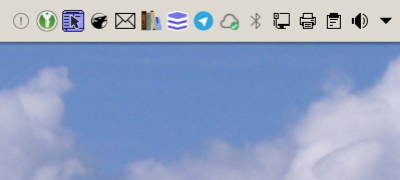One of these things that work without being noticed, is your system tray, or in short ‘systray’. It is the small area on the taskbar (aka ‘menu bar’ on Mac or ‘notification area’ on Windows) where active processes or programmes are indicated by their icons. Clicking or right-clicking usually presents a quick menu. It is all so obvious that we barely notice it.
Until an icon that ‘has always been there’ suddenly seems to have gone south. A wee thing that does itch. Where has it gone and how to get it back in its cage?

The following goes for a KDE Plasma desktop, but for GNOME, Cinnamon, MATE or Xfce it will possibly be rather similar. It is simple.
- First check if the application is actually on air by opening the System Monitor (ksysguard if need to start it manually).
- If the application is running, check if its *.desktop file is kept in ~/.local/share/applications. That is where your system looks for information about executables, names, icons etc.
- If the *.desktop file is there, but no icon shows inside the systray, check the permissions: owner and group should be the user’s, not the root’s. To change it from root to user, you need to have administrator rights, of course.
- If the *.desktop file is missing, find it in /usr/share/applications and copy it to ~/.local/share/applications. Check its permissions after copying.
- If the *desktop file cannot be found in /usr/share/applications, check where that application’s files are saved at installation. Your software manager, eg. Synaptic, should tell you.
- Finally, if the icon is still invisible, go to ‘Configure System Tray…’ (right-click on the small arrow to the right of your systray) and to ‘Entries’. Three options are given: Auto, Shown, Hidden. Should be self-explainable.
That’s it. One wee itch less!